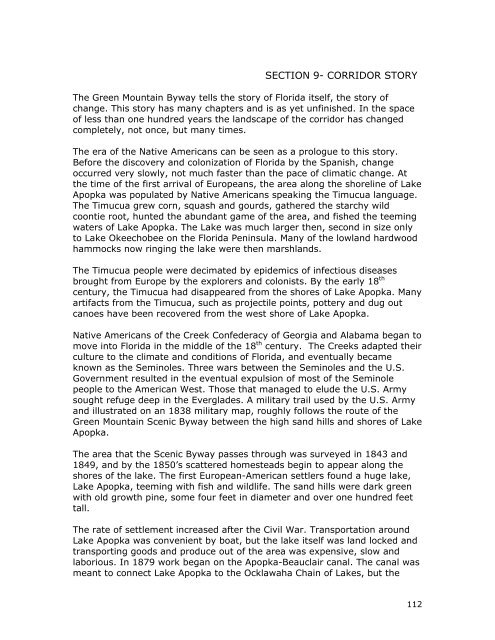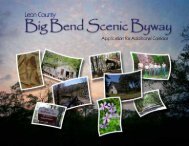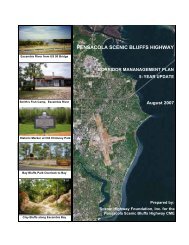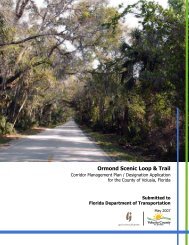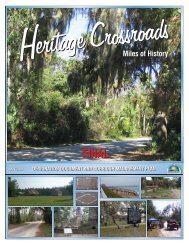GREEN MOUNTAIN SCENIC BYWAY - Florida Scenic Highways
GREEN MOUNTAIN SCENIC BYWAY - Florida Scenic Highways
GREEN MOUNTAIN SCENIC BYWAY - Florida Scenic Highways
- No tags were found...
You also want an ePaper? Increase the reach of your titles
YUMPU automatically turns print PDFs into web optimized ePapers that Google loves.
SECTION 9- CORRIDOR STORYSECTION 9- CORRIDOR STORYThe Green Mountain Byway tells the story of <strong>Florida</strong> itself, the story ofchange. This story has many chapters and is as yet unfinished. In the spaceof less than one hundred years the landscape of the corridor has changedcompletely, not once, but many times.The era of the Native Americans can be seen as a prologue to this story.Before the discovery and colonization of <strong>Florida</strong> by the Spanish, changeoccurred very slowly, not much faster than the pace of climatic change. Atthe time of the first arrival of Europeans, the area along the shoreline of LakeApopka was populated by Native Americans speaking the Timucua language.The Timucua grew corn, squash and gourds, gathered the starchy wildcoontie root, hunted the abundant game of the area, and fished the teemingwaters of Lake Apopka. The Lake was much larger then, second in size onlyto Lake Okeechobee on the <strong>Florida</strong> Peninsula. Many of the lowland hardwoodhammocks now ringing the lake were then marshlands.The Timucua people were decimated by epidemics of infectious diseasesbrought from Europe by the explorers and colonists. By the early 18 thcentury, the Timucua had disappeared from the shores of Lake Apopka. Manyartifacts from the Timucua, such as projectile points, pottery and dug outcanoes have been recovered from the west shore of Lake Apopka.Native Americans of the Creek Confederacy of Georgia and Alabama began tomove into <strong>Florida</strong> in the middle of the 18 th century. The Creeks adapted theirculture to the climate and conditions of <strong>Florida</strong>, and eventually becameknown as the Seminoles. Three wars between the Seminoles and the U.S.Government resulted in the eventual expulsion of most of the Seminolepeople to the American West. Those that managed to elude the U.S. Armysought refuge deep in the Everglades. A military trail used by the U.S. Armyand illustrated on an 1838 military map, roughly follows the route of theGreen Mountain <strong>Scenic</strong> Byway between the high sand hills and shores of LakeApopka.The area that the <strong>Scenic</strong> Byway passes through was surveyed in 1843 and1849, and by the 1850’s scattered homesteads begin to appear along theshores of the lake. The first European-American settlers found a huge lake,Lake Apopka, teeming with fish and wildlife. The sand hills were dark greenwith old growth pine, some four feet in diameter and over one hundred feettall.The rate of settlement increased after the Civil War. Transportation aroundLake Apopka was convenient by boat, but the lake itself was land locked andtransporting goods and produce out of the area was expensive, slow andlaborious. In 1879 work began on the Apopka-Beauclair canal. The canal wasmeant to connect Lake Apopka to the Ocklawaha Chain of Lakes, but the112


